Elegant emerald discs, with silvery rays radiating from the center – that’s the hallmark of Calathea orbifolia.
Essentially your mother’s best dinnerware in leaf form, the foliage from these tropical wonders is simply stunning to witness.
As with all Calathea (and crockery), this sensitive plant can be a little too easy to break. So, it does require some extra care, attention and… humidity, but don’t let that stop you growing this sublime beauty at home.
Whether you’re growing her in a pot or behind glass, she’s dressed to impress.
Armed with the right know-how, we’ll have you growing a Calathea you’ll be proud of!
Let’s get into it.
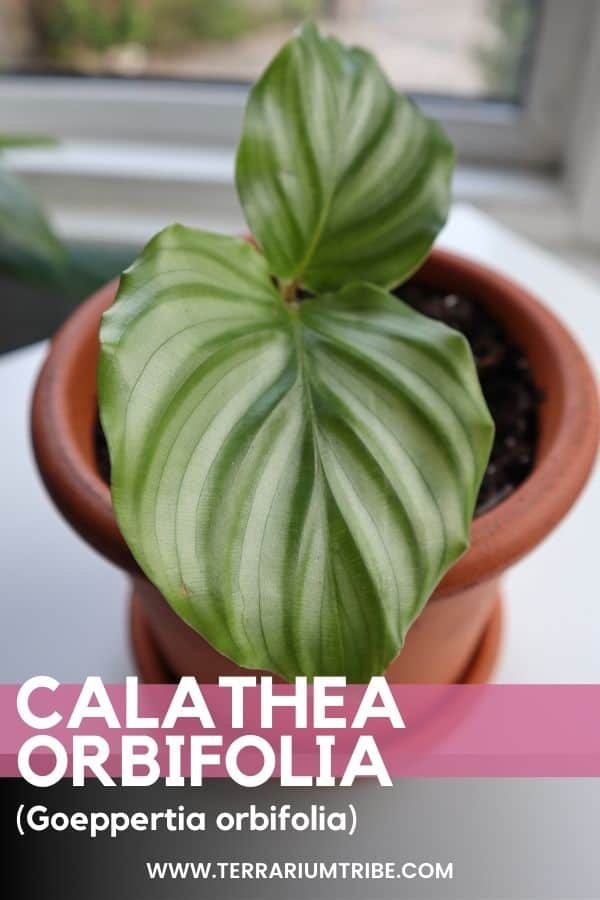
What is the Calathea orbifolia?
If you like your plant foliage big, round, and beautiful – you’ve found it in the Calathea orbifolia.
It’s the plant that’s so gorgeous, nobody could think of a common name to do it justice (honesty, I’ve no idea if that’s true… but it genuinely has no common name that i can find).
Being part of the Marantaceae family of plants, the characteristic round green leaves of Calathea orbiflia follow in the ways of the typical prayer plant. Opening through the day and gently folding at night.
She’s not the hardest Calathea out there to grow (probably because she’s technically classified as a Goeppertia now), but she’ll still give you a run for your money if you’re not careful.
Give her lots of (filtered) water and a balanced meal of nutrients and gentle light, and you’re good to go.
Where to Find Calathea orbifolia for Sale
See the links below to purchase from reputable terrarium plant shops and marketplaces (may include affiliate links).
Calathea orbifolia Care & Growth
At a Glance
| Plant Type | Foliage |
| Lighting | Bright indirect light |
| Temperature | 65-80°F (18-27°C) |
| Watering | Regular, even moisture |
| Humidity | Medium to high (50-80%) |
| Growth | 12-36 inches |
Lighting
Native to Brazil, you’d find Calathea orbifolia living it up on the rainforest floor.
Soaking up those glorious dappled rays that make it through the rainforest canopy, but carefully avoiding direct sunlight (she’s much too sensitive for that).
In the home, you’d do well to provide the same conditions as best you can.
Bright indirect light is the name of the game, and in this case it’s a must win game I’m afraid.
The delicate leaves of Calathea orbifolia will quickly burn in direct light, but conversely it’ll give you the most vibrant foliage when placed in a bright spot.
A delicate yet critical balance.
Ours is on the farthest side of a bookshelf that sees light from a southeast-facing window.
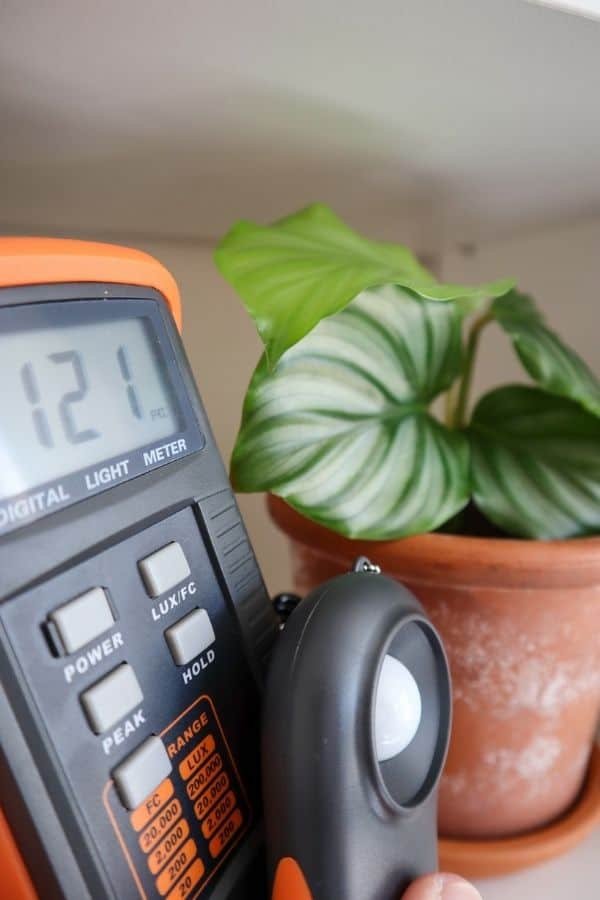
It’s about 10 feet in so it never gets any direct rays, but gets more than enough light for a Calathea to manage with.
She has grown previously in a much darker spot but much more slowly. It’s taken months to get a new leaf in the old position (which can be good if you want to keep yours small in a terrarium).
An ideal location might be in front of a North-facing window with its full days of bright but soft lighting conditions.
Watering
Like most tropical plants, Calathea orbifolia likes consistent moisture but hates soggy conditions.
So, it’s essential to provide frequent watering and plenty of drainage for these finicky plants.
Grown as indoor plants, opting for a container with a drainage hole is the easiest way to keep on top of this, and to reduce to the risk of root rot (of which these are particularly sensitive to).
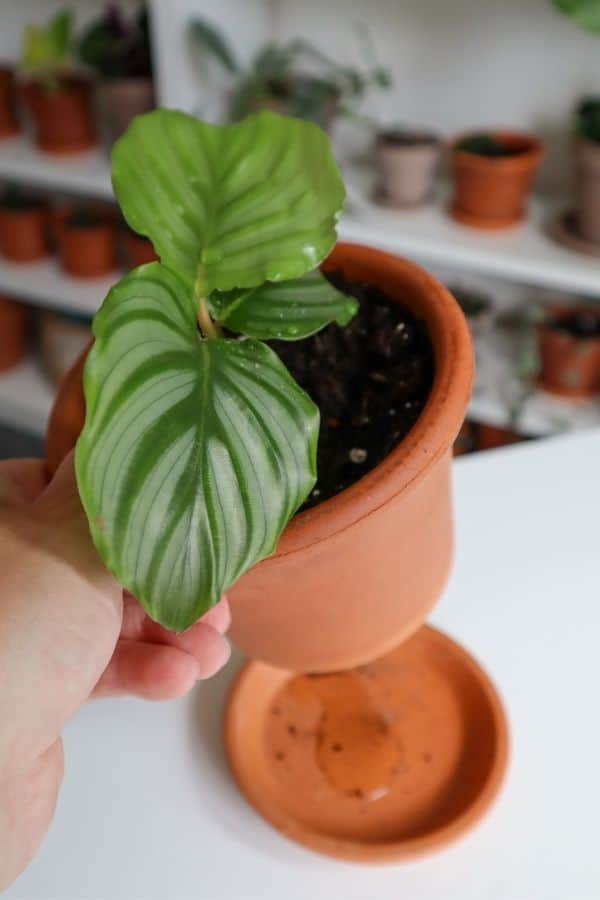
If you’re growing this plant in a terrarium, you’ll want to maintain a consistently light level of moisture. If the substrate looks wet, you’ve gone too far.
A quick note on the type of water, too.
Calathea are also known to be incredibly sensitive to salts and chemicals in water. So, it’s always recommended to water them with some form of purified water.
Distilled water and deionized water both work well, or rainwater is free!
That being said, where I live here in the Northeast of England, the tap water is pretty soft and I’ve always used that with no ill effects.
Substrate / Soil Mix
The key to a happy Calathea orbifolia is a substrate with a good balance of water retention and drainage.
They’ll quickly suffer if allowed to dry out, so consistent moisture is a must.
For this, I like to use a coco coir base. It’s light and fluffy, so it’ll provide plenty of aeration, but it can hold a tonne of water.
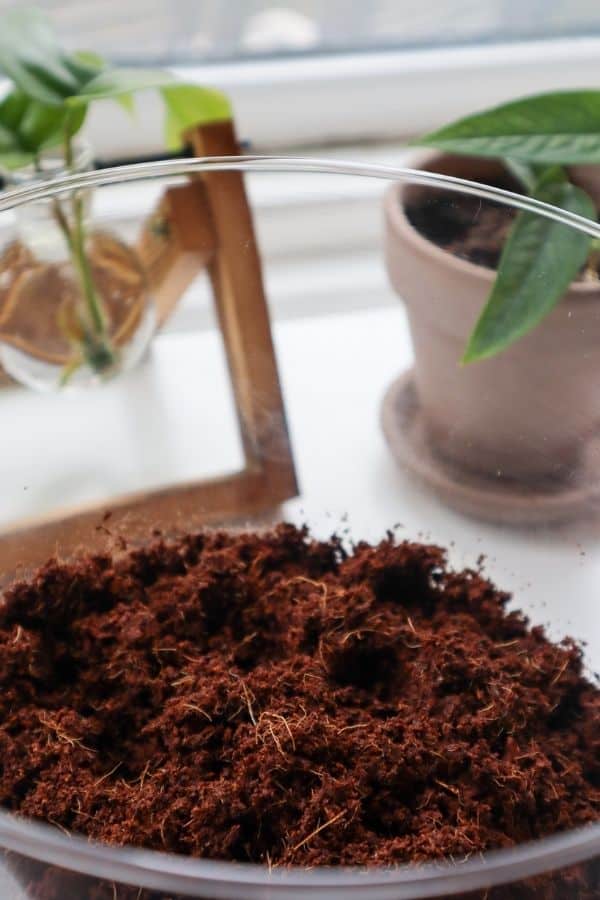
I’d recommend supplementing this with earthworm castings for slow-release nutrients (as this plant is also sensitive to strong liquid fertilizers).
Finally, you’ll need some additional materials to bring further aeration and drainage to the mix. I like to use orchid bark in terrarium mixes, but I’d also use perlite or pumice if growing indoors as a houseplant.
Temperature & Humidity
Calathea are sensitive plants and like a consistent environment to flourish.
In a terrarium this is nice and easy to control (hint hint), but in the home you’ll have to take care to protect your plant from drafts or shock changes.
A nice warm temperature and humid conditions are the best way to keep this tropical beauty happy.
She’ll thrive in the warm summer months, but unfortunately, cold air (and even colder winter months) can quickly spell the end.
Humidity is a key factor here, too.
Though Calathea orbifolia will grow happily in typical household temperatures (65-80°F), it really needs high humidity levels.
50% as a minimum, but the higher, the better.
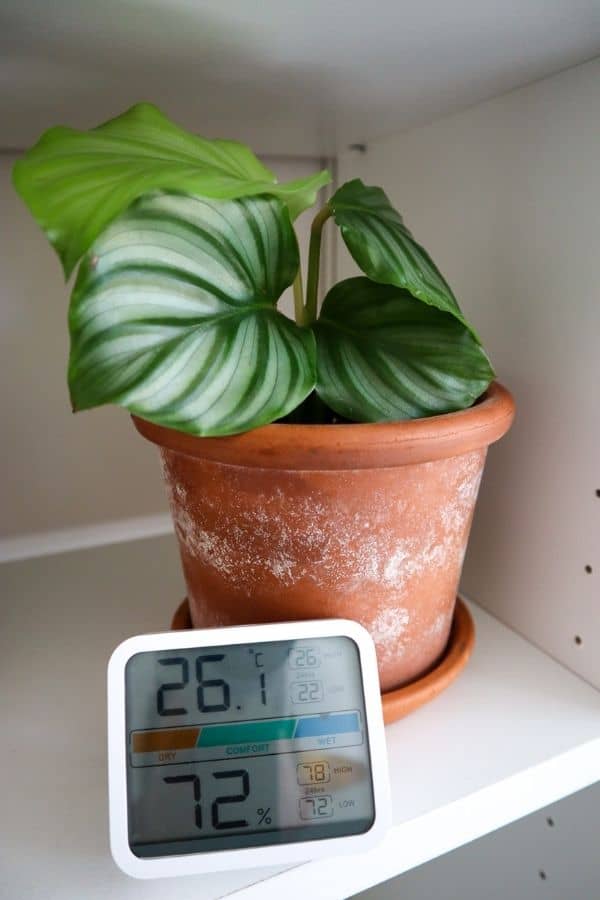
I grow my plant in a room that maintains around 75%, and it’s doing fine. I’ve never seen any of the characteristic crispy edges that come with low humidity.
If you’re struggling to keep the humidity, you can try leaving full watering cans around the room (that’s my favourite hack) and by grouping plants together.
Conveniently a terrarium solves all of these problems…
Growth
Personally, I don’t find Calathea orbifolia to be a quick grower.
Since getting mine as a baby plant over 6 months ago, it has only grown a couple of leaves and hasn’t increased much in size.
Under brighter light conditions, I’m sure it would move faster, though its foliage is still vibrant and healthy even in these minimal lighting conditions.
It’s true that these plants can get quite big given enough time – and those broad round leaves can really become dinner plate-sized – but I think it’ll be years before they get to that point.
Plus, it’s not like a quick snip every now and again won’t keep them small indefinitely. This plant is all leaf, after all.
That being said, as a terrarium plant, it’ll probably be best placed in a larger container where it can really spread out its foliage.
Personally, I’ve never seen one of these plants flower. But then, with such gorgeous foliage, do we need flowers?
Propagation
Like other Calathea, orbifolia is propagated primarily through root division.
Leaf or stem cutting won’t work here, so you’ll need a mature plant that’s developed enough that it can be separated into several smaller plants.
You can simply tease apart (or cleanly cut if necessary) the root ball/rhizome structure from the mother plant till you have a selection of individual plants, all with their own root systems.
These can be planted up directly and grown separately / given to friends!
Just don’t try this too often. It’s (understandably) quite a shock to the system and for the best chance of success you’ll want her in good health.
Varieties & Similar Plants
Though Calathea orbifolia is somewhat of an only child in having no varieties or cultivars, as part of the Marantaceae group, it has quite the extended family.
Full of other popular prayer plants like the Calathea makoyana, Calathea musaica or Calathea ornata (and Ctenanthe burle-marxii too).
Though nothing quite matches the silvery round foliage of Calathea orbifolia, there’s a huge amount of variety in shapes and colours.
Frequently Asked Questions
Calathea orbifolia can be a challenging plant to care for. It has a variety of specialized needs, and it’s particularly sensitive to temperature and humidity.
Calathea orbifolia needs moderate to bright indirect light to thrive. Though, it can manage in lower light conditions too, just with a reduced growth rate.
A droopy Calathea orbifolia is usually indicative of underwatering. Try giving your plant a thorough drink of water and see if it perks up.
Brown edges on leaves are a common theme in Calathea care, though they can be caused by a variety of issues. An insufficiently humid environment is one potential factor, or chemical burns from hard water or strong fertilizers could be the culprit, too.
